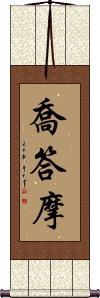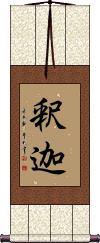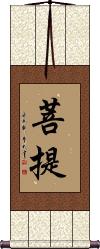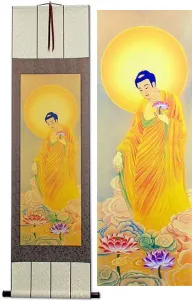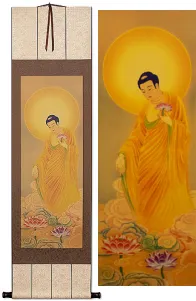Many custom options...
And formats...

Gautama in Chinese / Japanese...
Buy a Gautama calligraphy wall scroll here!
Personalize your custom “Gautama” project by clicking the button next to your favorite “Gautama” title below...
1. Gautama
2. Siddhartha
4. The Tree of Enlightenment / The Bodhi Tree
Gautama
Siddhartha
悉達多 is the name Siddhartha (as in Siddhartha Gautama), the personal name for Śākyamuni.
This same Buddha is also known as “Shakyamuni Gautama,” “Gotama Buddha,” or “Tathagata.”
Siddhartha Gautama was a spiritual teacher in the northern region of the Indian subcontinent who founded Buddhism. He is generally seen by Buddhists as the Supreme Buddha (Sammāsambuddha) of known human history.
The actual meaning of this name in Chinese is the realization of all aims, or simply being prosperous.
This name is sometimes romanized from the original Sanskrit or Pali as Siddhattha (from Siddhattha Gotama), Siddharth, Siddhārtha, or Sarvāthasiddha.
Siddhārtha or Sarvāthasiddha can also be written as 悉達, 悉多, 悉多頞他, or 悉陀.
Shakyamuni / The Buddha
釈迦 is the way to write Shakyamuni in Japanese.
It's just two Kanji, the first is a simplified version of the one used in Chinese for Shakyamuni, and the second one is identical to the Chinese.
This refers to the Buddha (Siddhartha Gautama, 563 BCE-483 BCE) also known as Sakyamuni and Gautama Buddha.
This has a very good meaning in Japanese but is an odd selection for a wall scroll. It appears here more for reference.
The Tree of Enlightenment / The Bodhi Tree
菩提樹 is the full title of the Bodhi tree (a fig tree) under which Siddhartha Gautama (the legendary man who established the Buddhist religion), achieved enlightenment.
Sometimes this is referred to as “the tree of enlightenment.” If you don't have a Bodhi tree to sit under, maybe you can achieve enlightenment under a wall scroll with this title.
Bodhi - Awakening Enlightenment
The Bodhi or 菩提 is the moment of completion in Buddhism.
It is when all things become known and you have completed your journey to enlightenment.
The reference is to the Bodhi tree where Siddhartha Gautama (the legendary man who established the Buddhist religion) achieved enlightenment. Sometimes this is referred to as “the tree of enlightenment,” but if you want the full version with the character for a tree at the end, please see the Bodhi Tree entry.
See Also: Buddhism | Buddha | Nirvana | Enlightenment
Shakyamuni / The Buddha
釋迦牟尼 is a transliteration of “Shakyamuni” or “Sakyamuni” in Chinese, Japanese, and old Korean.
The perceived meaning of the name is roughly translated as “Sage of the Sakyas.”
This same Buddha is also known as “Siddhartha Gautama,” “Gotama Buddha,” “Tathagata,” or simply, “The Supreme Buddha.”
Shakyamuni is the legendary man and prince who eventually established the Buddhist religion.
Note: Occasionally Romanized as “Siddhattha Gotama.”
This combination of characters is sometimes seen and used in South Korea and Japan as well (with the same meaning).
Note: 釋迦牟尼 came from the Sanskrit शाक्यमुनि and can also be romanized with diuretics as Śākyamuni.
This in-stock artwork might be what you are looking for, and ships right away...
Gallery Price: $200.00
Your Price: $69.88
Gallery Price: $200.00
Your Price: $69.88
Not the results for Gautama that you were looking for?
Below are some entries from our dictionary that may match your Gautama search...
| Characters If shown, 2nd row is Simp. Chinese |
Pronunciation Romanization |
Simple Dictionary Definition |
牛 see styles |
niú niu2 niu nyuu / nyu にゅう |
More info & calligraphy: Ox / Bull / Cow(1) cattle (Bos taurus); cow; bull; ox; calf; (2) {food} (usu. ぎゅう) (See 牛肉) beef; (3) (ぎゅう only) {astron} (See 二十八宿,玄武・げんぶ・2) Chinese "Ox" constellation (one of the 28 mansions); (surname) Nyū go, gaus; ox, bull, bullock, etc. A term applied to the Buddha Gautama as in 牛王 king of bulls, possibly because of the derivation of his name; the phrase 騎牛來牛 (or 騎牛覔牛) to ride an ox, to seek an ox, means to use the Buddha to find the Buddha. |
釈迦 see styles |
shaka しゃか |
More info & calligraphy: Shakyamuni / The Buddha |
喬答摩 乔答摩 see styles |
qiáo dā mó qiao2 da1 mo2 ch`iao ta mo chiao ta mo Kōtōma |
More info & calligraphy: GautamaGautama |
悉達多 悉达多 see styles |
xī dá duō xi1 da2 duo1 hsi ta to shiddaruta しっだるた |
More info & calligraphy: Siddhartha(personal name) Shiddaruta (悉達) Siddhārtha, Sarvāthasiddha, also悉多 (悉多頞他); 悉陀 the realization of all aims, prosperous; personal name of Śākyamuni. |
釋迦牟尼 释迦牟尼 see styles |
shì jiā móu ní shi4 jia1 mou2 ni2 shih chia mou ni Shakamuni |
More info & calligraphy: Shakyamuni / The Buddha釋迦文 (釋迦文尼); 釋伽文 Śākyamuni, the saint of the Śākya tribe. muni is saint, holy man, sage, ascetic monk; it is: intp. as 仁 benevolent, charitable, kind, also as 寂默 one who dwells in seclusion. After '500 or 550' previous incarnations, Śākyamuni finally attained to the state of Bodhisattva, was born in the Tuṣita heaven, and descended as a white elephant, through her right side, into the womb of the immaculate Māyā, the purest woman on earth; this was on the 8th day of the 4th month; next year on the 8th day of the 2nd month he was born from her right side painlessly as she stood under a tree in the Lumbinī garden. For the subsequent miraculous events v. Eitel. also the 神通遊戲經 (Lalitavistara), the 釋迦如來成道記, etc. Simpler statements say that he was born the son of Śuddhodana, of the kṣatriya caste, ruler of Kapilavastu, and Māyā his wife; that Māyā died seven days later, leaving him to be brought up by her sister Prājapati; that in due course he was married to Yaśodharā who bore him a son, Rāhula; that in search of truth he left home, became an ascetic, severely disciplined himself, and finally at 35 years of age, under a tree, realized that the way of release from the chain of rebirth and death lay not in asceticism but in moral purity; this he explained first in his four dogmas, v. 四諦 and eightfold noble way 八正道, later amplified and developed in many sermons. He founded his community on the basis of poverty, chastity, and insight or meditation, ad it became known as Buddhism, as he became known as Buddha, the enlightened. His death was probably in or near 487 B.C., a few years before that of Confucius in 479. The sacerdotal name of his family is Gautama, said to be the original name of the whole clan, Śākya being that of his branch, v. 瞿, 喬.; his personal name was Siddhārtha, or Sarvārthasiddha, v. 悉. |
世尊 see styles |
shì zūn shi4 zun1 shih tsun seson せそん |
World Honored One; Revered One of the World (Buddha) World-Honored One (honorific name for Gautama Buddha) lokajyeṣṭha, world's most Venerable, or lokanātha, lord of worlds. 盧迦委斯諦; 路迦那他 World-honoured, an epithet of every Buddha. Also a tr. of Bhagavat, v. 婆. |
佛陀 see styles |
fó tuó fo2 tuo2 fo t`o fo to budda |
Buddha (a person who has attained Buddhahood, or specifically Siddhartha Gautama) v. 佛 There are numerous monks from India and Central Asia bearing this as part of their names. |
倶譚 倶谭 see styles |
jù tán ju4 tan2 chü t`an chü tan Kutan |
Gautama |
具譚 具谭 see styles |
jù tán ju4 tan2 chü t`an chü tan Gudan |
Gautama, v. 瞿. |
前仏 see styles |
zenbutsu ぜんぶつ |
(1) {Buddh} Buddha prior to Gautama; (2) {Buddh} (See 後仏) Gautama Buddha; Shakyamuni; (surname) Zenbutsu |
因明 see styles |
yīn míng yin1 ming2 yin ming inmyou / inmyo いんみょう |
(See 五明) hetuvidya (ancient Indian logic for determining right from wrong, truth from falsehood, etc.) Hetuvidya, 醯都費陀, the science of cause, logical reasoning, logic, with its syllogistic method of the proposition, the reason, the example. The creation of this school of logic is attributed to Akṣapāda, probably a name for the philosopher Gautama (not Śākyamuni). The 因明論 or Hetu-vidyā-śāstra is one of the 五明論 pañcavidya-śāstras, a treatise explaining causality, or the nature of truth and error. |
後仏 see styles |
gobutsu ごぶつ |
{Buddh} (See 弥勒,前仏・2) Maitreya (buddha appearing 5.67 billion years after the death of Gautama) |
提婆 see styles |
tí pó ti2 po2 t`i p`o ti po daiba だいば |
(rare) {Buddh} deva (being with god-like characteristics); (person) Aryadeva; (person) Devadatta (cousin of Gautama Buddha) deva. Explained by 天 celestial; also by 梵天人 inhabitants of the brahmalokas, or by 天神 celestial spirits. General designation of the gods of Brahmanism, and of all the inhabitants of devalokas who are subject to metempsychosis. Also 提波; 提和; 提桓. Used also for Devadatta, infra. |
牛王 see styles |
niú wáng niu2 wang2 niu wang ushiou / ushio うしおう |
(surname) Ushiou The king of bulls, i. e. a Buddha, or bodhisattva; it is applied to Gautama Buddha, possibly derived from his name. |
瞿夷 see styles |
jù yí ju4 yi2 chü i Gui |
Gopā; Gopikā, a name of Yaśodharā, wife of Gautama and mother of Rāhula, cf. 憍 Gautamī; also 瞿毘耶; 瞿比迦; 瞿波; 瞿婆. |
瞿曇 瞿昙 see styles |
qú tán qu2 tan2 ch`ü t`an chü tan kudon くどん |
Gautama, surname of the Siddhartha, the historical Buddha (person) Gautama (the family name of Buddha) Gautama, the surname of Buddha's family; hence a name of Śākyamuni. Also 倶譚 or 具譚 later 喬答摩 q.v. |
衆天 众天 see styles |
zhòng tiān zhong4 tian1 chung t`ien chung tien Shuten |
Gautama-saṃghadeva |
釋迦 释迦 see styles |
shì jiā shi4 jia1 shih chia shaka しゃか |
sugar apple (Annona squamosa) (personal name) Shaka (釋迦婆) Śakra.; Śākya. the clan or family of the Buddha, said to be derived from śāka, vegetables, but intp. in Chinese as powerful, strong, and explained by 能 powerful, also erroneously by 仁charitable, which belongs rather to association with Śākyamuni. The clan, which is said to have wandered hither from the delta of the Indus, occupied a district of a few thousand square miles lying on the slopes of the Nepalese hills and on the plains to the south. Its capital was Kapilavastu. At the time of Buddha the clan was under the suzerainty of Kośala, an adjoining kingdom Later Buddhists, in order to surpass Brahmans, invented a fabulous line of five kings of the Vivartakalpa headed by Mahāsammata 大三末多; these were followed by five cakravartī, the first being Mūrdhaja 頂生王; after these came nineteen kings, the first being Cetiya 捨帝, the last Mahādeva 大天; these were succeeded by dynasties of 5,000, 7,000, 8,000, 9,000, 10,000, 15,000 kings; after which long Gautama opens a line of 1,100 kings, the last, Ikṣvāku, reigning at Potala. With Ikṣvāku the Śākyas are said to have begun. His four sons reigned at Kapilavastu. 'Śākyamuni was one of his descendants in the seventh generation.' Later, after the destruction of Kapilavastu by Virūḍhaka, four survivors of the family founded the kingdoms of Udyana, Bamyam, Himatala, and Sāmbī. Eitel. |
阿難 阿难 see styles |
ē nán e1 nan2 o nan anan あなん |
Prince Ananda, cousin of the Buddha and his closest disciple (person) Ananda (disciple of Gautama Buddha) Ānanda |
佛五姓 see styles |
fó wǔ xìng fo2 wu3 xing4 fo wu hsing butsugoshō |
The five surnames of Buddha before he became enlightened: 瞿曇 Gautama, a branch of the Śākya clan; 甘蔗Ikṣvāku, one of Buddha's ancestors; 日種 Sūryavaṁśa, of the sun race; 舍夷 ? Śāka; 釋迦 Śākya, the name of Buddha's clan. This last is generally used in China. |
喬答魔 乔答魔 see styles |
qiáo dá mó qiao2 da2 mo2 ch`iao ta mo chiao ta mo Kyōtōma |
Gautama. |
大愛道 大爱道 see styles |
dà ài dào da4 ai4 dao4 ta ai tao Daiai dō |
Mahā prajāpatī, 摩訶波闍波提 Gautama's aunt and foster-mother, also styled Gotami or Gautami, the first woman received into the order. There are sutras known by her name. 大愛 is also a name for the sea-god. |
憍曇彌 憍昙弥 see styles |
jiāo tán mí jiao1 tan2 mi2 chiao t`an mi chiao tan mi Kyōtonmi |
憍答彌; 倶答彌 Gautamī, feminine of the patronymic Gautama, the family name of Śākyamuni. Gautamī is a name for Mahāprājapatī, his aunt and nurse, who in the Lotus Sūtra is predicted to become Buddha. |
瞿曇仙 瞿昙仙 see styles |
jù tán xiān ju4 tan2 xian1 chü t`an hsien chü tan hsien Gudon sen |
An ancient ṛṣi, said to be one of the founders of the clan. |
瞿曇彌 瞿昙弥 see styles |
jù tán mí ju4 tan2 mi2 chü t`an mi chü tan mi Gudonmi |
Gautamī, the feminine of Gautama, especially applied to the aunt and nurse of Śākyamuni, who is also known as Mahāprājapatī, v. 摩. |
羅ご羅 see styles |
ragora らごら |
(kana only) Rahula (son of Siddhartha Gautama) |
藍毗尼 蓝毗尼 see styles |
lán pí ní lan2 pi2 ni2 lan p`i ni lan pi ni |
Lumbini, Nepal, birthplace of Siddhartha Gautama 釋迦牟尼|释迦牟尼[Shi4 jia1 mou2 ni2] founder of Buddhism (also written 嵐毘尼|岚毗尼[Lan2 pi2 ni2], 臘伐尼|腊伐尼[La4 fa2 ni2], 林微尼[Lin2 wei1 ni2]) |
釋迦佛 释迦佛 see styles |
shì jiā fó shi4 jia1 fo2 shih chia fo |
Sakyamuni Buddha (Sanskrit: sage of the Sakya); Siddhartha Gautama (563-485 BC), the historical Buddha and founder of Buddhism |
阿難陀 阿难陀 see styles |
ē nán tuó e1 nan2 tuo2 o nan t`o o nan to ananda あなんだ |
Prince Ananda, cousin of the Buddha and his closest disciple (person) Ananda (disciple of Gautama Buddha) Ānanda, 阿難; intp. by 歡喜 Joy; son of Droṇodana-rāja, and younger brother of Devadatta; he was noted as the most learned disciple of Buddha and famed for hearing and remembering his teaching, hence is styled 多聞; after the Buddha's death he is said to have compiled the sutras in the Vaibhāra cave, v. 畢, where the disciples were assembled in Magadha. He is reckoned as the second patriarch. Ānandabhadra and Ānandasāgara are generally given as two other Ānandas, but this is uncertain. |
ゴータマ see styles |
gootama ゴータマ |
(surname) Gautama |
Click here for more Gautama results from our dictionary
The following table may be helpful for those studying Chinese or Japanese...
| Title | Characters | Romaji (Romanized Japanese) | Various forms of Romanized Chinese | |
| Gautama | 喬答摩 乔答摩 | Kou tou ma / Koutouma / Ko to ma | qiáo dā mó qiao2 da1 mo2 qiao da mo qiaodamo | ch`iao ta mo chiaotamo chiao ta mo |
| Siddhartha | 悉達多 悉达多 | shiddatta / shiddaruta | xī dá duō xi1 da2 duo1 xi da duo xidaduo | hsi ta to hsitato |
| Shakyamuni The Buddha | 釈迦 | sha ka / shaka | shì jiā / shi4 jia1 / shi jia / shijia | shih chia / shihchia |
| The Tree of Enlightenment The Bodhi Tree | 菩提樹 菩提树 | bodaiju | pú tí shù pu2 ti2 shu4 pu ti shu putishu | p`u t`i shu putishu pu ti shu |
| Bodhi - Awakening Enlightenment | 菩提 | bodai | pú tí / pu2 ti2 / pu ti / puti | p`u t`i / puti / pu ti |
| Shakyamuni The Buddha | 釋迦牟尼 释迦牟尼 | sha ka mu ni shakamuni | shì jiā móu ní shi4 jia1 mou2 ni2 shi jia mou ni shijiamouni | shih chia mou ni shihchiamouni |
| In some entries above you will see that characters have different versions above and below a line. In these cases, the characters above the line are Traditional Chinese, while the ones below are Simplified Chinese. | ||||
Successful Chinese Character and Japanese Kanji calligraphy searches within the last few hours...
